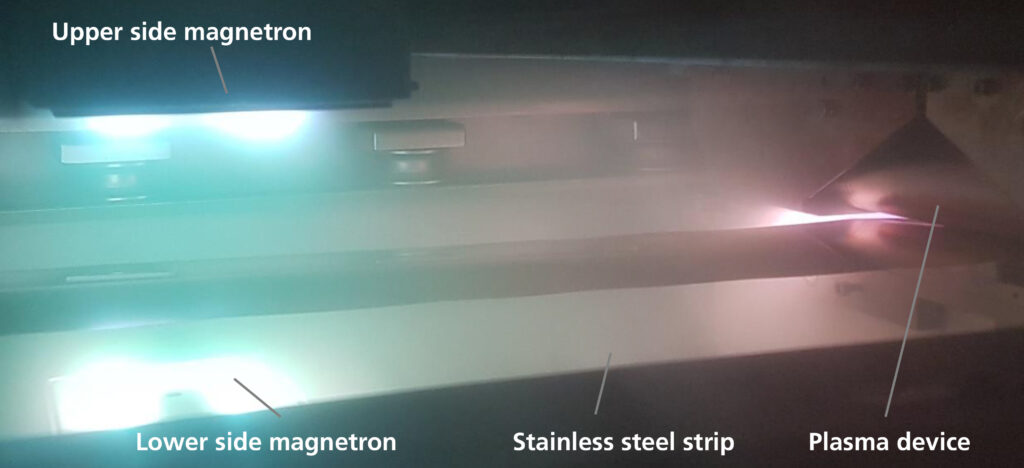
Innovative roll-to-roll plasma process for graphene layers
Graphene has the potential for outstanding performance gains in solar cells, organic light-emitting diodes (OLEDs), electrical energy storage devices or smart windows and even membranes, e. g. for seawater desalination. Its phenomenal properties are impressive: the material is transparent, lightweight, and stronger than steel. Graphene also has a high electrical and thermal conductivity and is very flexible.
Due to its high electrical conductivity, the integration of graphene into energy storage devices such as batteries or supercapacitors is a promising approach to enhance charging and discharging cycles. Its large surface area also enables a higher capacity and energy density, while the mechanical stability of the material contributes to the service life and reliability of such storage devices.
So far, scalability issues have been a bottleneck in getting graphene into applications. In addition, the integration of graphene into existing manufacturing processes is a technical challenge.
The Fraunhofer FEP has more than 30 years of experience in the development of coating systems with tailored properties. The research institute’s core competencies are electron beam and sputter technologies as well as plasma surface technologies, e. g. for the development of roll-to-roll processes for homogeneous thin films.
Recently, Fraunhofer FEP has made progress in a new technology for the synthesis of graphene using PECVD (Plasma Enhanced Chemical Vapor Deposition) and demonstrated a proof of concept for a pioneering low-cost graphene deposition process.
Current synthesis processes for graphene require the application of high temperatures and the use of catalysts. Fraunhofer FEP utilizes plasma-assisted processes. This allows the parameter window for the synthesis of graphene to be significantly expanded, so that deposition is also possible at lower substrate temperatures and higher throughputs at the same time.
To develop the new process, Fraunhofer FEP uses the versatility of the inline coating tool MAXI. Depending on the maturity of the process, the multifunctional vacuum coating plant offers the possibility to run processes in sheet-to-sheet as well as in roll-to-roll mode. Moreover, the variety of processes at the MAXI allows for pilot production, providing good prerequisites for the development and scaling of graphene deposition processes.
Now graphene can be deposited on metallic strips using the innovative PECVD process in the roll-to-roll mode. In the first step, the metal strip is coated with a thin layer of a catalyst material such as copper in vacuum. This allows the desired substrate material to be selected independently of the suitable catalyst material. The coated metal strip is then fed into a process unit containing an argon plasma. Its argon ions collide with the substrate and heat it efficiently in a very short time. By adding suitable precursor gases such as methane or acetylene, the respective molecules can be cracked into their constituents and partially ionized at the same time. Ideally, the resulting carbon atoms and ions are deposited on the substrate in a monolayer, well-ordered 2D structure, thus synthesizing the desired layer of graphene.
Due to the plasma ion assistance the formation process can be realized at comparatively lower substrate temperatures than in other state-of-the-art processes.
Using the newly developed PECVD process, Fraunhofer FEP is able to synthesize graphene layers on metal strips with a width of 280 mm at a strip speed of one meter per minute. The process thus enables high production throughput and is associated with cost savings for perspective production processes. In addition, the technology allows for an expansion of the substrate materials that can be used, resulting in a broader range of applications.
Now, Fraunhofer FEP works on the reproducibility of the results and on the further improvement of the layer properties, e. g. the number of graphene layers. Furthermore the institute is focusing on the improvement of the precise control of the plasma and temperature conditions for uniform layer quality and morphology and the winding process of the hot strip and further upscaling the current process parameters.
Deliverables
– synthesis of graphene layers on metal strips with a width of 280 mm at a strip speed of one meter per minute
– proof of concept for a pioneering low-cost graphene deposition process.
– using plasma-assisted processes for depositzion of graphene layers at lower substrate temperatures and higher throughputs at the same time
More Info and Video
Contact Listings Owner Form
- Learn about who has visited this offer
- Get funding opportunities matching this technology
- Get detailed access statistics as listing owner
